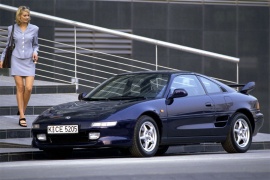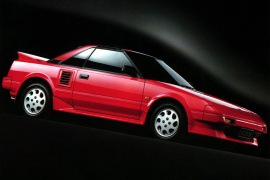TOYOTA MR2 Models/Series Timeline, Specifications & Photos
First production year: 1985
Engines: Gasoline
Body style: Coupé (two-door)
Toyota introduced the second generation of the MR2 in 1989 for the 1990 model year and continued the story of its mid-engined sporty vehicle with an even more exciting model than its predecessor, and it was not just about the power.
Creating a vehicle that didn’t share any of its underpinnings besides the engine with other cars from Toyota’s lineup didn’t make too much sense for this brand. Still, it did it to attract young customers into its showrooms. Those were the years when the Japanese automaker made not just one but several exciting, sporty vehicles, such as the Celica or the Supra MKIV. The MR2 was a different kind of sports car. It was small, nimble, and had its engine placed behind the cabin, making it impractical for any family duties, but it was fast and fun to drive. And that’s what many young customers asked for.
In the late ‘80s and early ‘90s, there were just a handful of vehicles available with mid-mounted engines, and most of them were expensive supercars. Toyota dared to make it and priced it within the same brackets as a four-door Camry. At the front, the car featured a low nose and pop-up headlights, like its predecessor, but styled differently, with curved lines instead of wedged shapes. The bumper housed the parking lights and the blinkers, while in the lower area, it sported a grille with horizontal slats and a set of fog lamps, which were on the options list.
From its profile, the MR2 featured an ascending waistline and cab-rearward greenhouse. Its two-door coupe silhouette resembled a Ferrari, and that’s why it earned its reputation as the “Baby Ferrari.” Toyota installed a set of air intakes behind the rear doors that fed air into the engine compartment. To further enhance engine cooling, the automaker added a set of vents on the lid that covered it behind the cabin. Finally, at the back, the automaker installed a wing on the rear deck and dual exhausts that peaked under the rear bumper for a sportier appearance.
Inside, the two-seat MR2 offered low-mounted bucket seats separated by a center console. The instrument cluster placed in front of the driver provided information about speed, revs, water temperature, and fuel level. In addition, the turbocharged versions got a turbocharger boost gauge. The center stack housed the HVAC system controls and the sound system, which, as an option, featured both a cassette and an in-dash CD player. Toyota made the MR2 available with a T-top, so customers could remove two panels from the roof and leave just a longitudinal beam for a cabrio-like sensation.
Behind the cabin, Toyota installed different engines, according to the market where the car was sold. The top-of-the-range version was a turbocharged two-liter powerplant that provided swift accelerations, especially when mated with the five-speed manual gearbox.
After the failure of Fiat X1/9 and the Porsche 914, Toyota tried its muscles with a mid-engine, light car, sports car for the masses. It was the first-gen MR2, launched in 1984.
Despite its uninspired name, that meant: Mid-engine, Rear-wheel-drive, 2-seat, the MR2 was sold well all over the world. In French-speaking countries, it was named only MR, since the MR2 sounded very close to the word “merde” (go-ahead, google it). But the car was the exact opposite of that.
Its boxy-shape with not a curved line in its bodywork was somehow appreciated by the market. In the mid-'80s, Toyota had a wide range of sports or sporty cars and the MR2 was the entry-level. Its pop-up headlights, a small cabin, and a short deck made it attractive for the market. Since it was very light, it was nimble and very fuel-efficient. The small engine featured a fuel-injection system, which led to good power output.
Inside, there was room for two passengers, as the name promised, and nothing more. Behind the seats there was nothing, but at least the roof featured a removable glass panel. The low-mounted dashboard with a small instrument cluster was designed into a minimalist style.
The most common engine was the 1.6-liter unit carried-over from the Corolla. It featured electronic fuel injection supplied by Denso and a variable intake camshaft. It was mated as standard to a 5-speed manual, but a 4-speed automatic was on the options list.

